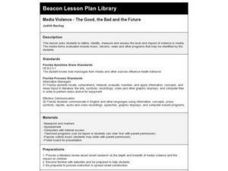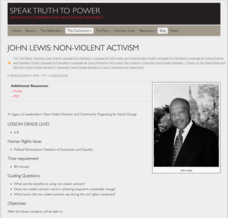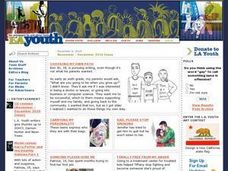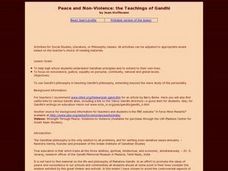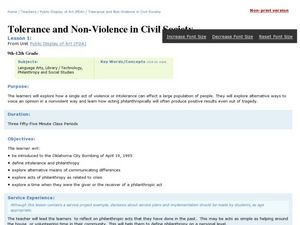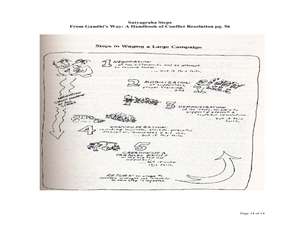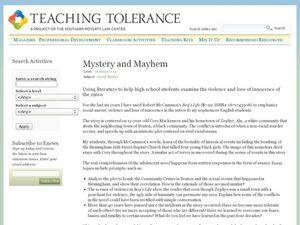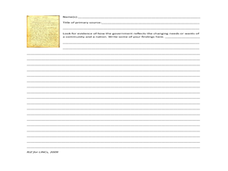Speak Truth to Power
Dalai Lama: Free Expression and Religion
How is religious freedom connected to the conflict between China and Tibet? After reading an online passage of background information, your learners will divide into groups and both read and view an interview with the Dalai Lama. They...
K12 Reader
Glossary of Non-Violence
Make sure your class is sure of terminology when referring to the non-violent methods used in the civil rights movement. This glossary includes 19 terms paired with parts of speech and definitions.
Curated OER
Applying Ahimsa to Traditional Stories
Investigate the life of Mahatma Gandhi by researching non-violent lifestyles. Learners define the word ahimsa and discuss the personal characteristics that made Gandhi a peaceful warrior. They also create a poster about the story "The...
Curated OER
ESL Holiday Lessons: International Day of Non-Violence
For this language skills worksheet, students read an article regarding International Day of Non-Violence. Students respond to 6 matching questions, 29 fill in the blank questions, 30 multiple choice questions, 12 word ...
Curated OER
Media Violence - The Good, the Bad and the Future
Third graders define, identify, measure, and assess the level and impact of violence in media. The media forms evaluated include music, sitcoms, news, and other programs that are identified and shared by the class.
Speak Truth to Power
John Lewis: Non-Violent Activism
After comparing and contrasting non-violent and violent social movements, your young historians will take a closer look at the work and influence of John Lewis on the civil rights movement. They will then choose a current social justice...
Curated OER
The Five Values
Students brainstorm and explore the five values of life: truth, love, peace, right conduct and non-violence. They bounce ideas off each other to assess more of a knowledge of each value. In addition, they write their reflections of each...
Curated OER
Gandhi Speech Writing
Explore non-violent protest in this social values and world history lesson. After viewing the movie Gandhi, and discussing important events in Gandhi's life, young orators write a speech defending Gandhi's position on the value of...
Curated OER
To Fight Or Not To Fight: a Debate About Violence Encourages Critical Thinking Skills
Students read article about student violence, discuss why it happens, and explore non-violent options.
Curated OER
Promote Nonviolence
Take a look at the topic of violence as seen in Harper Lee's To Kill a Mockingbird. Discuss together the values that Atticus holds and brainstorm ways to combat violence in a similar manner to what he portrays in the novel. Get your...
Curated OER
Violence On TV
Students examine violence on TV. In this data collection lesson, students explore TV violence. Students watch TV shows and fill out a checklist about the amount of violence. Students organize and analyze the information to make a report.
Curated OER
Peace and Non-Violence: the Teachings of Gandhi
Students study the Gandhian philosophy. They define certain elements such as power, beauty and discuss what they know about the struggle for independence in India. Finally students collaborate to discuss Gandhian principles to extend...
Curated OER
An Introduction to the Season for Nonviolence
Fourth graders create a Venn diagram and a cause and effect graphic organizer on Gandhi and King. In this non violence lesson plan, 4th graders compare the two non violent leaders and discuss and articulate non violent protests and write...
Curated OER
Socratic Seminar on Martin Luther King, Jr.’s Letter From Birmingham Jail
Key in the struggle to gain the rights of democratic citizenship was the April 1963 arrest of Dr. Martin Luther King, Jr. for civil disobedience. To deepen their knowledge and understanding of events during the civil rights movement,...
Curated OER
Tolerance and Non-Violence in Civil Society
Students explore the concept of philanthropy. In this Oklahoma City bombing lesson, students submit public responses to the event in order to consider how the tragedy prompted a positive reaction. Extension activities are included.
Curated OER
Gandhi's Non-violent Revolutions: Examining Tools to Make Non-violent
Students analyze Gandhi's philosophy of nonviolent social change. In this nonviolence and social change lesson, students research a leader from the attached list who practiced nonviolent social change. Students write their own poem...
Curated OER
Civil Disobedience from Antigone to Hunger Games
Study the concepts and practice of civil disobedience through fiction and nonfiction texts.
PBS
Martin Luther King Jr.: Civil Rights Leader
Expand class members' appreciation of the work of Dr. Martin Luther King, Jr. A powerful resource examines King's speeches, writings, and actions that reveal his deep commitment to a nonviolent approach to Civil Rights. Learners watch a...
Curated OER
Mystery and Mayhem
Young scholars use literature to examine the violence and loss of innocence during the 1960s. In this U.S. history lesson, students read Robert McCammon's Boy's Life to investigate the social unrest, violence and loss of innocence in the...
Curated OER
Individual Empowerment in the Face of Oppression
Sixth graders investigate non-violent ways of dealing with conflicts by performing short plays. In this philosophy instructional activity, 6th graders discuss how men can gain power in a non-violent manner similar to Gandhi's actions....
Curated OER
Looking for Heroes
Pupils explain the importance of the 1965 Selma-to-Montgomery Voting Rights March and the long term impact in the US of non violent civic participation.
Curated OER
Ahimsa and Making Nonviolent Choices with Gandhi and King
Students investigate nonviolent lifestyles by researching the biographies of Martin Luther King Jr and Gandhi. In this peace lesson, students define the term Ahimsa and describe Gandhi's lifestyle. Students identify the six principles...
Curated OER
Towards Separation of Church and State in Gloucester
Explore New England government in the 1700's with your class. They will identify historical documents as primary or secondary sources, then read and discuss the significance of these documents as they relate to the "freedom of religion"...
EngageNY
Grade 9 ELA Module 4, Unit 1, Lesson 22
Class members read "Satyagraha," the concluding section of Marc Aronson and Marina Budhos' Sugar Changed the World: A Story of Magic, Spice, Slavery, Freedom, and Science, and analyze how the authors support their claim that terrible...
Other popular searches
- Peace and Non Violence
- Non Violence Statistics
- Gandhi, Non Violence
- Gandhi Non Violence
- Non Violence Candi
- Non Violence Gandi
- Gandhi\, Non Violence
- King Non Violence
- Gandhi\\, Non Violence
- Peace and Non Violence
- Gandhi\\\\, Non Violence
- Teach Non Violence






